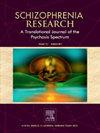Schizophrenia spectrum disorders in children and adolescents: Clinical, phenomenological, diagnostic, and prognostic features across subtypes
IF 3.6
2区 医学
Q1 PSYCHIATRY
引用次数: 0
Abstract
Schizophrenia spectrum disorders (SSD) typically have a diagnostically recognizable onset in young adulthood, yet it is not unusual that help-seeking due to initial SSD-related clinical manifestations emerge in earlier developmental phases, such as childhood and adolescence. Varieties of SSD manifestations in children and adolescents can be distinguished according to variations in clinical expressivity, severity and timing (i.e. developmental stage). Some individuals may reach the full clinical threshold for a diagnosis of schizophrenia according to the same descriptive diagnostic criteria used for adults, and in this case, it's possible to distinguish a pre-pubertal onset in childhood (aka Very Early Onset Schizophrenia, VEOS) and a post-pubertal onset in adolescence (aka Early Onset Schizophrenia, EOS). Other individuals may not reach such clinically overt diagnostic threshold but nonetheless present Childhood Schizotypal Disorder (CSD) or a Clinical High-Risk for Psychosis (CHR![]() P). While EOS is clinically more similar to the canonical adult-onset presentation, the other 3 subgroups (i.e. VEOS, CSD, CHR
P). While EOS is clinically more similar to the canonical adult-onset presentation, the other 3 subgroups (i.e. VEOS, CSD, CHR![]() P) present more nuances and specific clinical characteristics, which require ad-hoc developmental and phenomenological considerations for appropriate differential diagnosis and prognosis. Therefore, current scoping review intends to saturate such knowledge gap with respect to early SSD-phenotypes.
P) present more nuances and specific clinical characteristics, which require ad-hoc developmental and phenomenological considerations for appropriate differential diagnosis and prognosis. Therefore, current scoping review intends to saturate such knowledge gap with respect to early SSD-phenotypes.
儿童和青少年精神分裂症谱系障碍:各亚型的临床、现象学、诊断和预后特征
精神分裂症谱系障碍(SSD)在诊断上通常在青年时期发病,但在较早的发育阶段,如儿童和青少年时期,因最初的 SSD 相关临床表现而寻求帮助的情况并不少见。根据临床表现、严重程度和时间(即发育阶段)的不同,可以区分儿童和青少年的各种 SSD 表现。根据与成人相同的描述性诊断标准,有些人可能达到了精神分裂症诊断的临床阈值,在这种情况下,可以区分青春期前发病的儿童期(又称极早发精神分裂症,VEOS)和青春期后发病的青少年期(又称早发精神分裂症,EOS)。还有一些人可能没有达到这种临床诊断阈值,但却表现为儿童分裂型障碍(CSD)或临床精神病高危人群(CHRP)。虽然 EOS 在临床上更类似于典型的成人发病表现,但其他 3 个亚群(即 VEOS、CSD、CHRP)表现出更多细微差别和特定的临床特征,这就需要在适当的鉴别诊断和预后方面对其发展和现象进行专门考虑。因此,本次范围界定综述旨在填补有关早期 SSD 表型的知识空白。
本文章由计算机程序翻译,如有差异,请以英文原文为准。
求助全文
约1分钟内获得全文
求助全文
来源期刊

Schizophrenia Research
医学-精神病学
CiteScore
7.50
自引率
8.90%
发文量
429
审稿时长
10.2 weeks
期刊介绍:
As official journal of the Schizophrenia International Research Society (SIRS) Schizophrenia Research is THE journal of choice for international researchers and clinicians to share their work with the global schizophrenia research community. More than 6000 institutes have online or print (or both) access to this journal - the largest specialist journal in the field, with the largest readership!
Schizophrenia Research''s time to first decision is as fast as 6 weeks and its publishing speed is as fast as 4 weeks until online publication (corrected proof/Article in Press) after acceptance and 14 weeks from acceptance until publication in a printed issue.
The journal publishes novel papers that really contribute to understanding the biology and treatment of schizophrenic disorders; Schizophrenia Research brings together biological, clinical and psychological research in order to stimulate the synthesis of findings from all disciplines involved in improving patient outcomes in schizophrenia.
 求助内容:
求助内容: 应助结果提醒方式:
应助结果提醒方式:


